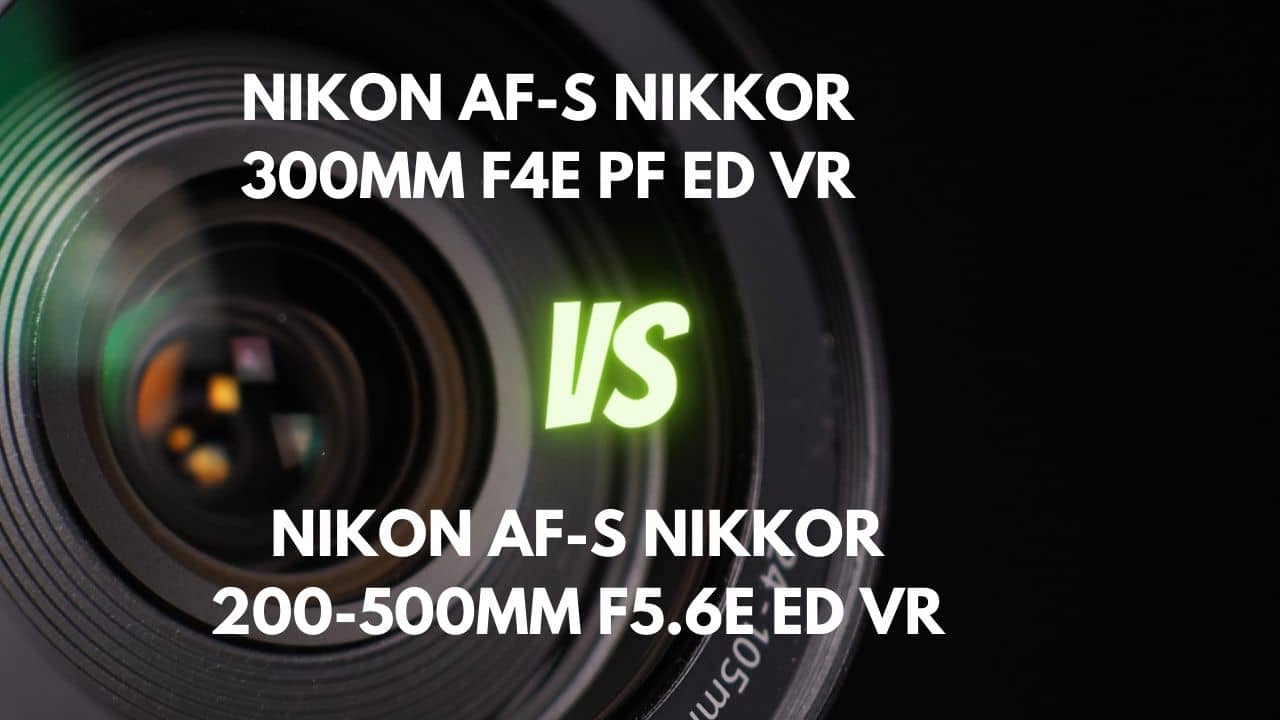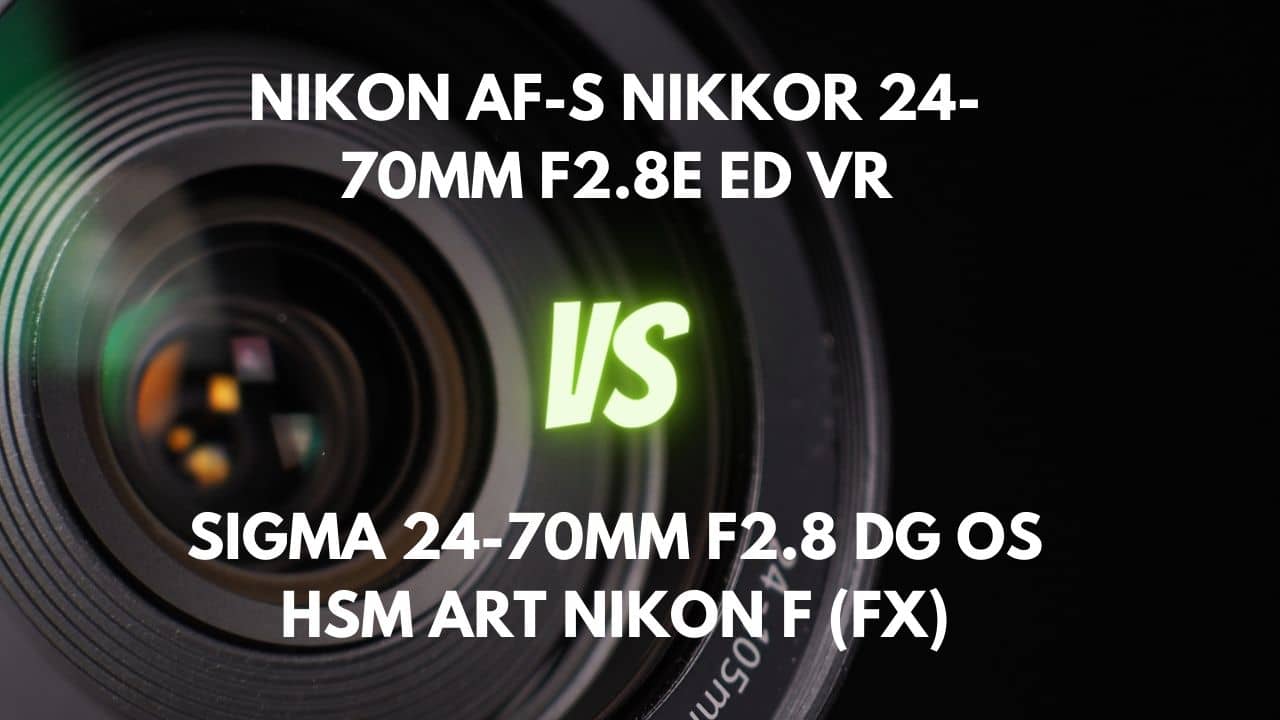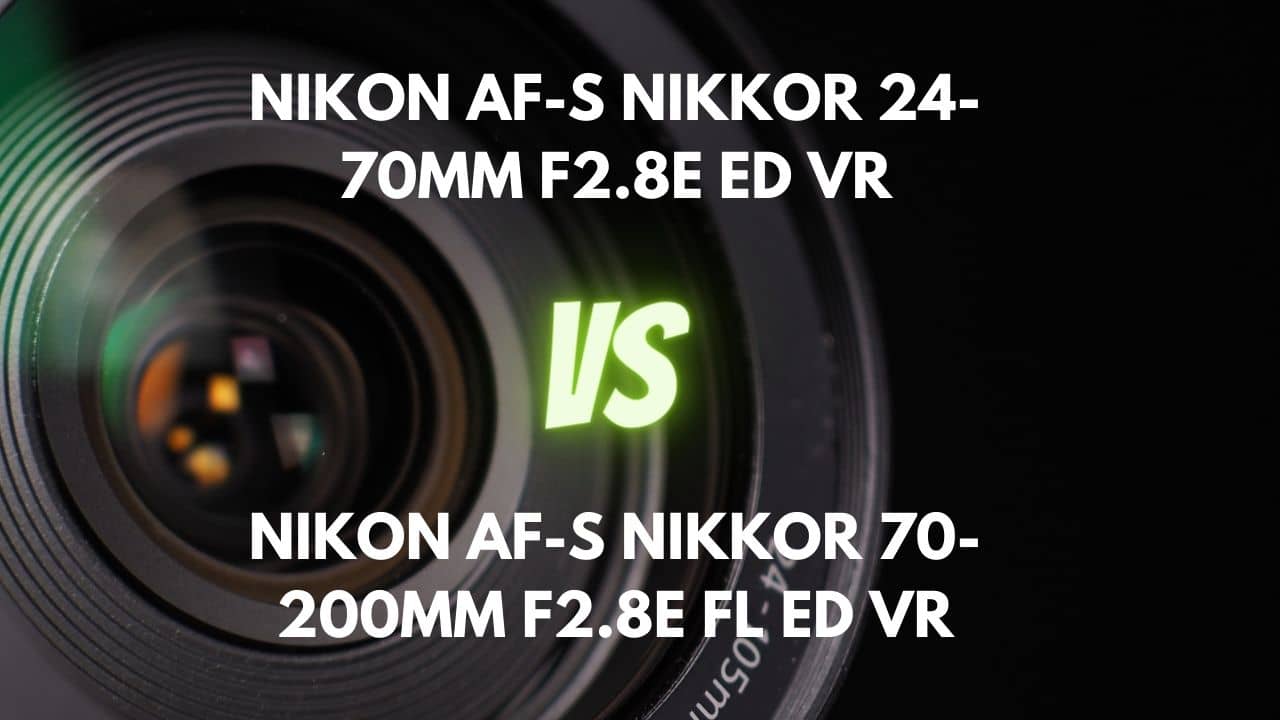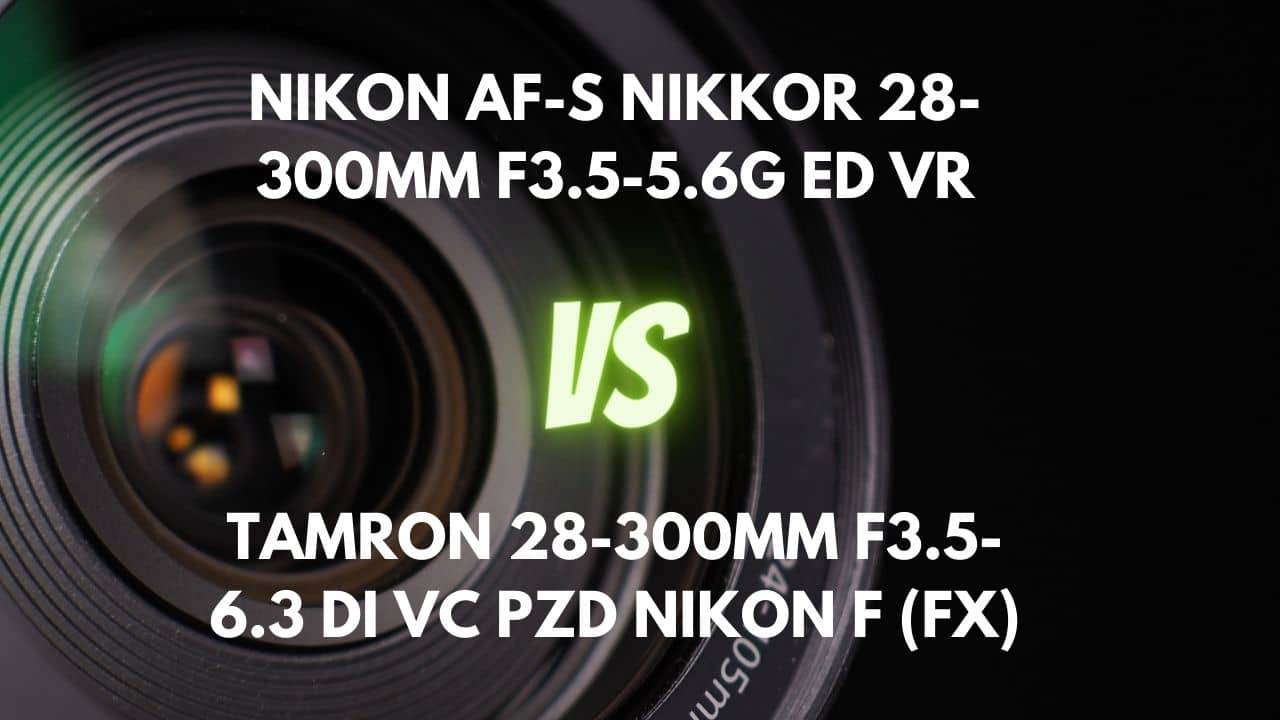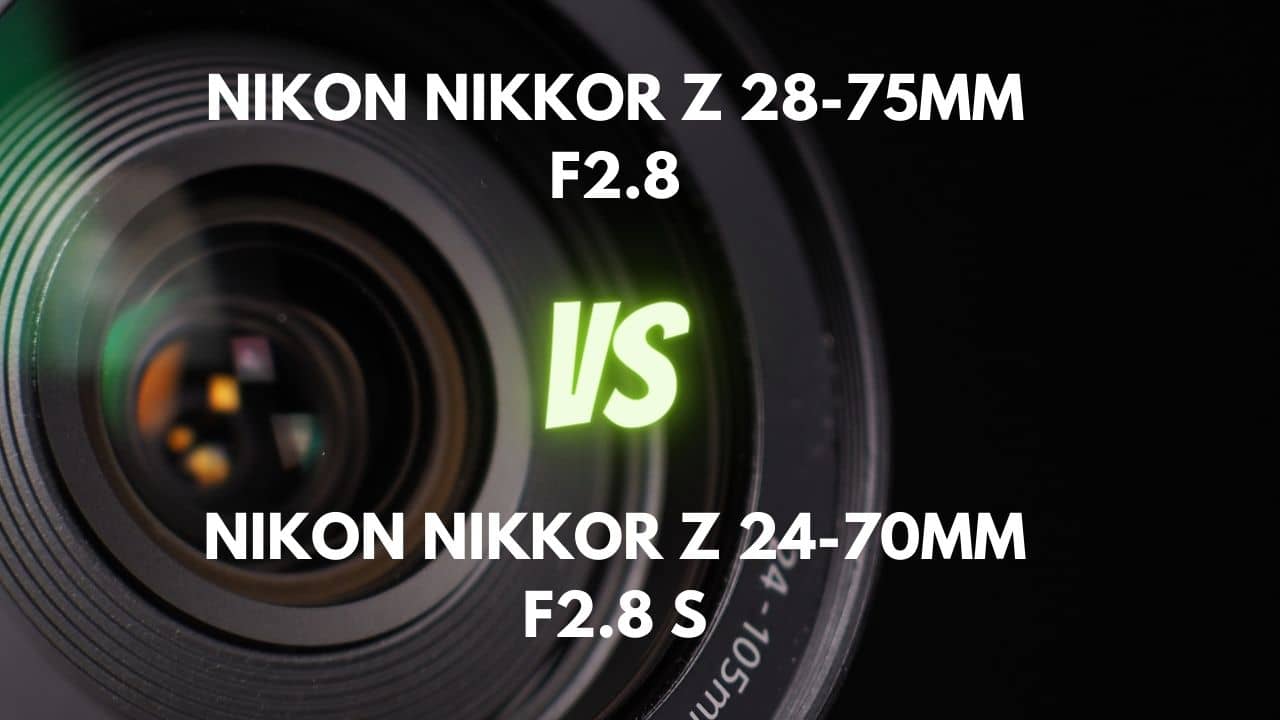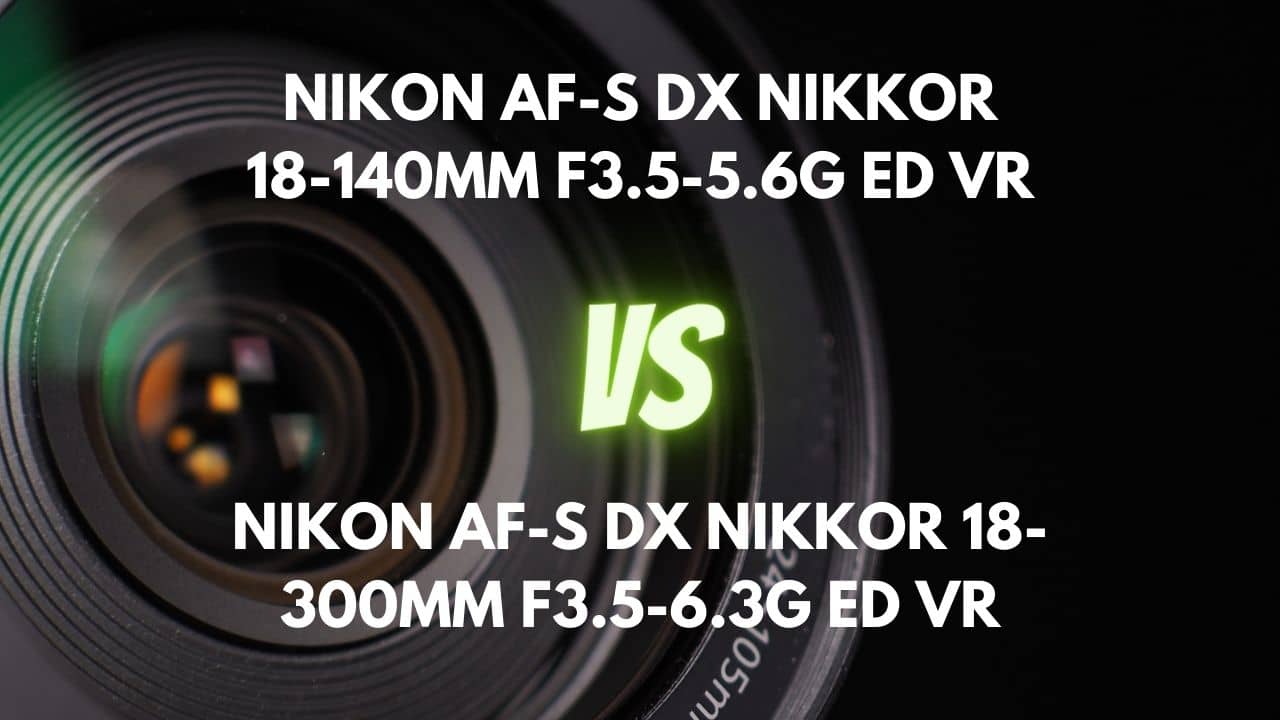Have you ever found yourself caught in the crossroads of lens selection, juggling between the versatility of a superzoom and the quality of a standard zoom?
Whether you’re a seasoned professional or an enthusiastic hobbyist, the choice of the right lens can make or break your photography game. That’s why we’re bringing you a detailed comparison between two lenses that are game-changers in their respective categories – the Nikon 24-70mm f/2.8 and the Nikon 28-300mm f/3.5-5.6.
As photographers, we all appreciate the importance of having the right tool for the job. From capturing stunning landscapes to documenting fleeting moments in a bustling city, or from shooting intimate portraits to seizing the action at a sports event, different photography genres demand different lens characteristics. Understanding this can help us better navigate the multitude of choices available.
The 24-70mm lens, with its superior low light performance and overall sharpness, is a darling of professional photographers, while the 28-300mm lens, with its exceptional versatility and affordability, is a boon for travel enthusiasts and those seeking a ‘one lens fits all’ solution. By pitting these two giants against each other, we aim to help you understand their strengths and weaknesses across various photography scenarios.
In the following article, you’ll gain insight into these lenses’ performance in areas such as distortion, vignetting, chromatic aberration, and more. Plus, you’ll learn how they fare under different conditions and which lens might be the better choice for your specific photography needs.
So, whether you’re looking to upgrade your gear, expand your creative possibilities, or simply deepen your understanding of photography, this comparison will provide valuable insights to inform your decision and enhance your craft.
Dive in to discover the world of possibilities these lenses can unlock in your photographic journey!
Overview
| Nikon AF-S NIKKOR 24-70mm F2.8E ED VR | Nikon AF-S NIKKOR 28-300mm F3.5-5.6G ED VR | |
|---|---|---|
| Max Aperture | F2.8 | F3.5-5.6 |
| Aperture Type | Fixed | Variable |
| Focal Range (mm) | 24-70 | 28-300 |
| Mount Type | Nikon F (FX) | Nikon F (FX) |
| Max Format | 35mm FF | 35mm FF |
| Zoom Ratio (X) | 2.9 | 10.7 |
The Nikon 24-70mm f/2.8 and the Nikon 28-300mm f/3.5-5.6, both designed for the Nikon F (FX) mount, cater to different photography needs. Each has its own unique strengths and drawbacks depending on your shooting requirements and preferences.
The 24-70mm lens has a fixed aperture of f/2.8. This means it can maintain a consistent maximum aperture across its entire focal range, providing better low light performance and a shallower depth of field. This is particularly useful when you want to isolate your subjects with a pleasing background blur, or when shooting in low light conditions.
Additionally, the fixed aperture often indicates higher optical quality, delivering sharper images with less distortion and chromatic aberration. However, this lens covers a relatively limited focal range, from wide-angle to a short telephoto, making it versatile for many situations such as landscape, street, and portrait photography.
On the other hand, the 28-300mm lens features a variable aperture of f/3.5-5.6, meaning the maximum aperture changes as you zoom in or out. When zoomed out at 28mm, the lens can open up to f/3.5, but when zoomed in to 300mm, the maximum aperture decreases to f/5.6. This characteristic can limit the lens’s performance in low light situations, especially at longer focal lengths.
On the upside, this lens offers a significantly broader focal range, from a moderate wide-angle to a long telephoto, giving you a high level of flexibility to adapt to various scenarios such as travel, events, or wildlife photography. However, variable aperture lenses may not deliver the same level of image quality as their fixed aperture counterparts, and you might see compromises in sharpness, distortion, or chromatic aberration.
Both lenses are designed for full-frame (35mm FF) cameras, meaning they can take advantage of the sensor’s large size for improved image quality and low light performance. They also share the Nikon F (FX) mount type, making them compatible with Nikon’s range of full-frame DSLR cameras.
In conclusion, the decision between these two lenses comes down to your specific needs and shooting style. If you prioritize low light performance, consistent image quality, and the ability to create a shallow depth of field, the 24-70mm f/2.8 lens could be the superior choice for you. However, if you require a broader range of focal lengths to accommodate diverse shooting scenarios and value versatility over low light performance, the 28-300mm f/3.5-5.6 lens might be the better fit.
Design and Ease of Use
| Nikon AF-S NIKKOR 24-70mm F2.8E ED VR | Nikon AF-S NIKKOR 28-300mm F3.5-5.6G ED VR | |
|---|---|---|
| Diameter x Length (mm) | ⌀88×154.5mm | ⌀83×114.5mm |
| Weight (gr) | 1070 | 800 |
| Filter Thread (mm) | 82 | 77 |
| Weather Sealing | Yes | No |
| Zoom Method | Rotary (internal) | Rotary (extending) |
| Distance Scale | Yes | Yes |
| DoF Scale | No | No |
| Hood Supplied | Yes | Yes |
| Hood Code | HB-74 | HB-50 |
The Nikon 24-70mm f/2.8 and Nikon 28-300mm f/3.5-5.6 each offer distinct characteristics and advantages, with their differences lying primarily in their dimensions, weight, and zoom method.
The 24-70mm lens is slightly larger, with a diameter and length of 88mm and 154.5mm, respectively. In contrast, the 28-300mm lens is more compact, measuring 83mm in diameter and 114.5mm in length. This size difference could influence your decision based on your portability needs.
A smaller lens like the 28-300mm is easier to carry around, particularly during travel or long photography sessions. The compactness of the 28-300mm lens could also make you less conspicuous, beneficial for street or wildlife photography. However, a larger lens like the 24-70mm might offer more robustness, which some photographers may prefer.
In terms of weight, the 24-70mm lens is heavier at 1070 grams, while the 28-300mm lens weighs 800 grams. The lighter weight of the 28-300mm lens enhances portability, reduces fatigue during extended use, and makes lens swapping easier. However, the weight difference also affects balance; a heavier lens like the 24-70mm could make your camera feel front-heavy, possibly leading to handling difficulty.
The zoom method for these lenses differs as well. The 24-70mm lens uses an internal rotary zoom method, meaning the lens does not physically extend when zooming in or out. This keeps the camera’s balance consistent, potentially making it easier to handle. This type of zoom is generally more resistant to dust and moisture due to its better weather sealing, which is particularly beneficial for outdoor photography. However, the complexity of this design could lead to a higher price and potential for more parts to malfunction.
On the other hand, the 28-300mm lens uses an extending rotary zoom method. The lens physically extends when zooming, which may affect the camera’s balance and handling. This design might make effective weather sealing more difficult, possibly making the lens more susceptible to dust and moisture. Nonetheless, the simplicity of the extending zoom design typically results in lower prices and potentially increased durability.
In conclusion, if you prioritize robustness, consistent balance, and better weather sealing, the 24-70mm lens would be the superior choice. However, if your emphasis is on portability, discreetness, and cost-effectiveness, the 28-300mm lens would be more suitable.
Lens Mount and Barrel
Starting with the Nikon 24-70mm f/2.8, it features a metal lens mount which is fortified by weather-sealing and an O-ring. This not only creates a robust and durable connection to the camera but also minimizes the ingress of dust and water, essential for photographers shooting in harsh conditions.
In contrast, the Nikon 28-300mm f/3.5-5.6 has a solid metal lens mount with a dull-chromed brass finish. It includes a rubber seal for basic dust protection. Although it may not provide the same level of weather sealing as the 24-70mm lens, its sturdy construction ensures a secure and reliable connection to the camera.
As for the lens barrel, the 24-70mm lens sports a mix of high-quality plastic and metal construction, with a rubberized texture finish. This blend of materials balances durability and weight, making it manageable for extensive use.
However, the 28-300mm lens has a predominantly plastic barrel with a tactile rubber covering on the zoom ring. This design contributes to a lighter weight, improving portability. Yet, the plastic construction may be less resistant to wear over time. Furthermore, this lens extends physically when zooming, expanding up to three inches at 300mm. This extension might affect handling and balance during use, especially at maximum zoom.
In conclusion, if you are seeking a lens with robust weather sealing and a durable, balanced construction, the 24-70mm lens may be more suitable. However, if you prefer a lighter and more affordable lens, despite some potential compromise on durability and stability at full zoom, the 28-300mm lens could be the better choice.
Weather Sealing
The Nikon 24-70mm f/2.8 and 28-300mm lenses present divergent characteristics when it comes to weather sealing, a feature that equips a lens with resistances against environmental elements such as dust and moisture, contributing to its durability and performance.
Looking at the 24-70mm lens first, it has robust weather sealing, fortified against water, dust, and smudges. The lens mount boasts a rubber grommet seal that minimizes dust and water intrusion. Further, there are internal seals at essential points including the rings, switches, and the barrel’s front.
This lens is made with the intention to withstand harsh weather conditions, making it a great choice for photographers who frequently shoot outdoors or in unpredictable environments. However, it’s crucial to remember that it is not invincible against extreme weather changes. Swift transitions between extreme cold and warm conditions can lead to condensation and potential internal moisture accumulation.
On the other hand, the Nikon 28-300mm f/3.5-5.6 does not promote explicit weatherproofing. It has a rubber seal around the lens mount for basic dust protection, but it does not have internal seals at the rings, switches, and front of the barrel. Additionally, it lacks a fluorine coating on the front element. These missing elements might limit its reliability in challenging weather conditions, making it less suitable for photographers who operate extensively in outdoor or unpredictable environments.
In conclusion, from a weather sealing standpoint, the 24-70mm lens emerges superior due to its comprehensive protective measures against environmental elements. However, the need for weather sealing largely depends on your specific photography needs and conditions. If you’re frequently shooting in harsh environments, the 24-70mm lens with its extensive weather sealing would be an excellent choice. On the contrary, if your photography is primarily indoors or in controlled conditions, the 28-300mm lens might serve you well, potentially at a lower cost.
Rings
The Nikon 24-70mm f/2.8 and Nikon 28-300mm f/3.5-5.6 both offer distinctive features in relation to their rings, which are critical components affecting the user’s comfort, control, and shooting experience.
For the 24-70mm lens, there are two rings: a rubberized zoom ring situated at the rear and a manual focus ring positioned towards the front. The zoom ring presents a broad grip with raised ribs for enhanced tactile feel, and it rotates smoothly with slight resistance, allowing precise zooming from wide to telephoto in a quarter turn.
The focus ring, though narrower, is equally comfortable and smooth to use. It also offers soft stops at the minimum focus distance and infinity for further control. Although it lacks an infrared or depth of field markings on the focus indicator, it compensates with a windowed distance scale with marks in both feet and meters. The lens design ensures that the lens hood stays put while zooming, despite the absence of an extension lock switch on the zoom ring.
In comparison, the 28-300mm lens also features two rings – a zoom ring at the front and a focus ring closer to the mount. The zoom ring is coated with tactile rubber, surfaced with raised ribs, and well-sized for two fingers to move through its 90-degree turning radius.
On the other hand, the focus ring is narrow and composed of grippy plastic. While it lacks a depth-of-field indicator, it makes up for it with a distance scale located behind a window. This lens also has a zoom lock switch at 28mm to prevent zoom creep, a feature not present in the 24-70mm lens.
While both lenses have well-considered designs in terms of their rings, the 24-70mm lens offers a slightly superior experience. The rubberized texture on both rings and the soft stops on the focus ring allow for comfortable and precise manipulation. This, combined with a constant lens hood position during zooming, provides an improved user experience. However, the 28-300mm lens does offer the advantage of a zoom lock switch.
Switches/Buttons
The Nikon 24-70mm f/2.8 and Nikon 28-300mm f/3.5-5.6 both present distinct options when it comes to switches/buttons, which are critical for adjusting settings and enhancing the overall user experience.
In the 24-70mm lens, there are two switches located on the side of the barrel. One is the AF/MF switch, which provides the capability to manually override the autofocus to manual operation almost instantly. The other is the VR (Vibration Reduction) switch with settings for Off, Normal, or Active VR modes, catering to different shooting scenarios. However, it’s worth noting that while these switches are clearly labeled, their identical feel could be a slight disadvantage for a user who is working hastily and relying purely on touch.
On the other hand, the 28-300mm lens offers three switches on its barrel. It includes a switch for toggling the Vibration Reduction system, another for switching between manual and autofocus, and a third one for selecting between active and normal modes. An extra advantage this lens brings is the user-friendly design of its switches. They are easy to locate and operate, which can streamline the shooting process.
In conclusion, both lenses offer substantial switch/button configurations, but the superiority lies in the user’s specific requirements. If you value an instantaneous manual override of autofocus and are comfortable with two switches, the 24-70mm lens could be your preferred choice. However, if you favor more accessible and distinguishable switches, the 28-300mm lens, with its three easy-to-use switches, would be a more suitable option.
Filter Thread
When it comes to the filter thread, the Nikon 24-70mm f/2.8 and Nikon 28-300mm f/3.5-5.6 each offer unique features that cater to different needs and preferences of photographers.
The 24-70mm lens comes with an 82mm filter thread size, larger than the previous model, necessitating larger filters. While larger filters might be more expensive, they offer a wider selection and can reduce vignetting or potential degradation of image quality due to stacked filters.
An important characteristic of this lens is its internal focusing mechanism which keeps the filter position fixed as the lens focuses. This feature simplifies the use of certain filters, such as circular polarizers or graduated neutral density filters, which require a fixed orientation to function properly.
In contrast, the 28-300mm lens offers a 77mm filter thread, a common size with a broad range of filters available at reasonable prices. This thread size also aligns with many other telephoto lenses, facilitating filter sharing and potentially reducing costs for photographers with a collection of similar lenses.
The filter thread on this lens is made of plastic, which is lighter and can bounce back from impact better than metal threads. This lens also features a non-rotating filter thread, which, like the 24-70mm lens, allows for convenient use of filters such as polarizing and neutral density filters.
Comparatively, it’s challenging to decisively declare one superior over the other as the better filter thread largely depends on your specific needs and existing gear. If you prefer a larger filter size and an internal focusing mechanism, the 24-70mm lens would be a good fit. Conversely, if you want compatibility with other telephoto lenses and a lightweight plastic thread, the 28-300mm lens might be a better choice.
Lens Hood
The Nikon 24-70mm f/2.8 and Nikon 28-300mm f/3.5-5.6 come with distinct lens hood designs, which are instrumental in reducing lens flare, protecting the lens, and enhancing image quality.
For the 24-70mm lens, the lens hood included is a plastic petal-style hood, denoted as HB-74. It features a lock mechanism that ensures a secure attachment to the lens, a trait not common in all lens hoods. The design of this hood is deep, which aids in reducing lens flare and protecting the front element.
Importantly, it can be reversed for easy storage on the lens. The hood’s attachment point is located just forward of the gold stripe on the barrel to accommodate an inner barrel that moves during zooming. This design ensures the lens hood doesn’t need readjusting while zooming. However, at 24mm, the coverage of the lens hood is somewhat scant.
The 28-300mm lens, on the other hand, includes a plastic bayonet HB-50 hood that has a petal design, particularly effective at wider ends. This hood can be smoothly rotated and has a matte finish on the interior, which helps to reduce reflections. The material and finish are entirely plastic, contributing to its light weight.
In conclusion, both lens hoods offer valuable features, but your preference would depend on your specific needs. The 24-70mm lens hood, with its secure locking mechanism and versatile design that doesn’t need readjusting during zooming, might be a superior choice for photographers who frequently adjust their zoom. Conversely, if you prefer a lens hood that can be smoothly rotated and is lightweight, the 28-300mm lens hood would be the better fit.
Focusing and Optical Stabilization
| Nikon AF-S NIKKOR 24-70mm F2.8E ED VR | Nikon AF-S NIKKOR 28-300mm F3.5-5.6G ED VR | |
|---|---|---|
| Autofocus | Yes | Yes |
| AF Motor | Silent Wave Motor | Silent Wave Motor |
| Rotating Front Element | Does not rotate on focusing | Does not rotate on focusing |
| Min Focus Distance | 0.41m(24,28,70mm);0.38m(35-50mm) | 0.5m |
| Max Magnification (X) | 0.27 | 0.32 |
| Full-Time Manual Focus | Yes | Yes |
| Focus Method | Internal | Internal |
Focusing Performance
The Nikon 24-70mm f/2.8 and Nikon 28-300mm f/3.5-5.6 present noticeable differences in their focusing performance, impacting their suitability for various photography scenarios.
The 24-70mm lens boasts impressive autofocus performance. It’s snappy and quick, making it easy to acquire and transition focus swiftly, a vital feature for action or event photography. It operates silently, a significant advantage when recording videos where unwanted noise can be an issue. The lens displays excellent autofocus accuracy in both daylight and low-light conditions, snapping into focus nearly every time, especially when used with the latest-generation DSLRs, known for improved light sensitivity range and advanced AF systems.
The lens features a no slack/play focus ring enabling easy manual focus override, and the manual focus action is smooth. Importantly, it’s an internally focusing design, meaning the lens length remains constant, irrespective of the focus and zoom settings, and the front element doesn’t rotate during focusing. This lens also doesn’t exhibit focus breathing, beneficial in video work where changes in framing can be distracting.
In contrast, the 28-300mm lens exhibits decent autofocus performance, but might struggle with fast-moving subjects, such as birds in flight. While the focusing speed is respectable, it’s not instantaneous, taking about a second to go from infinity to 0.5m, and it can occasionally hunt for focus, particularly at longer focal lengths. The autofocus motor isn’t entirely silent, emitting a high-pitched whining noise during operation, though it’s generally not noticeable to the subject. Autofocus accuracy is reliable across all settings, delivering sharp results under various conditions.
Manual focus override is available, with a smooth action for precise adjustments. Similar to the 24-70mm lens, it features an internally focusing design, maintaining a constant length irrespective of focus and zoom settings. However, this lens exhibits focus breathing at 300mm, though it’s not an optical defect. In low-light situations, the lens may struggle more with focusing speed and accuracy, but the built-in vibration reduction system can help compensate for slower shutter speeds.
In conclusion, both lenses offer distinctive focusing performance, depending on your needs. The 24-70mm lens, with its quick and silent autofocus, excellent accuracy, and lack of focus breathing, is superior for fast-paced or video scenarios. Conversely, the 28-300mm lens, while slower and noisier, offers decent autofocus performance, and suit situations where fast-moving subjects are less of a concern.
Optical Stabilization
The Nikon 24-70mm f/2.8 and Nikon 28-300mm f/3.5-5.6 both offer optical stabilization features but differ in their efficacy and functionality.
The 24-70mm lens is equipped with an optical stabilization (VR) system, allowing for exposure times up to 4 stops longer, thus ensuring effective image stabilization even at slower shutter speeds. This is particularly beneficial for handheld shooting in low-light conditions where slower shutter speeds are necessary.
The lens offers both Normal and Active modes of stabilization, catering to different shooting scenarios. The VR system operates seamlessly and quietly, contributing to the overall user experience. Moreover, the autofocus, powered by a virtually silent AF-S drive, complements the lens’s optical stabilization. This lens performs admirably in handheld shooting, capturing clear shots even at shutter speeds as slow as 1/5-second when shooting at 70mm.
On the other hand, the 28-300mm lens houses the latest Vibration Reduction (VR II) technology, compensating for camera shake equivalent to a shutter speed increase of roughly 4 stops. This lens also offers Normal and Active stabilization modes, with Normal mode addressing quick and small vibrations and Active mode compensating for broader types of movement.
A unique feature of this lens is the ability to view the stabilizing effect through the viewfinder in both modes, enhancing the user’s confidence and compositional accuracy during shooting. This lens can also produce sharp handheld images at slower shutter speeds, which can reach as low as 1/13th of a second depending on the focal length used.
In conclusion, while both lenses provide effective optical stabilization, the 28-300mm lens appears to have a slight edge due to its latest VR II technology and the ability to visually confirm stabilization through the viewfinder. This makes it superior for scenarios requiring slow shutter speeds and significant camera shake compensation, such as handheld shooting at longer focal lengths or in lower light conditions.
Image Quality
| Nikon AF-S NIKKOR 24-70mm F2.8E ED VR | Nikon AF-S NIKKOR 28-300mm F3.5-5.6G ED VR | |
|---|---|---|
| Special Elements | 3 aspherical and 2 ED elements + nano crystal and fluorine coatings | 2 ED glass elements 3 aspherical elements |
| Diaphragm Blades | 9 | 9 |
| Circular Aperture | Yes | Yes |
Aberration
In considering aberration, both the Nikon 24-70mm f/2.8 and the Nikon 28-300mm f/3.5-5.6 show different levels and types of optical distortions.
The 24-70mm lens displays chromatic aberration at varying degrees. Most notable is the lateral chromatic aberration, particularly at the 35mm focal length, where it exceeds 3 pixels at the image borders. Longitudinal chromatic aberration (LoCA) is also present, introducing a subtle magenta coloration in the foreground and greenish tones in the background.
This lens also exhibits some coma, manifesting as slight distortion around bright points of light in night shots. Despite these aberrations, the lens doesn’t show significant spherochromatism, preserving reasonably neutral out-of-focus highlights. Importantly, most of the chromatic aberrations can be effectively corrected in post-production.
The 28-300mm lens, on the other hand, shows chromatic aberration as blue-magenta fringing on high-contrast edges, especially towards the corners. However, thanks to the use of Extra-low Dispersion (ED) glass elements, these aberrations are generally well-controlled. This lens doesn’t have significant issues with coma or saggital coma flare, preventing smeared distortions around bright light points.
Some spherical aberration is present, especially when focusing at closer distances, although it’s not overly pronounced. Like with the 24-70mm, the impact of these aberrations on image quality can be reduced through post-processing or optimal aperture and focal length settings.
In conclusion, while both lenses exhibit chromatic and other aberrations, the 28-300mm lens appears to better control these distortions. Consequently, in terms of aberration performance, the 28-300mm lens is superior, offering images that require less post-processing correction.
Sharpness
Diving into the realm of sharpness, both the Nikon 24-70mm f/2.8 and Nikon 28-300mm f/3.5-5.6 showcase different strengths at varying focal lengths and apertures.
The 24-70mm lens exhibits a good degree of center sharpness across its range, albeit slightly softer when used at its widest aperture. Sharpness drops significantly from 50mm onwards, with the corners being most affected.
However, achieving peak sharpness becomes possible when the aperture is stopped down to around f/5.6. The lens also holds up well with a teleconverter, although minor sharpness loss may occur. The optimal aperture for sharpness varies but generally falls between f/5.6 and f/8.
On the other hand, the 28-300mm lens presents a similar trend of sharpness, with center sharpness being decent, but showing some softness when used at wide-open apertures. Corner sharpness is at its best between f/8 and f/16, showing noticeable softness at wide-open apertures, especially at the telephoto end. Like the 24-70mm, stopping down improves sharpness dramatically, with peak sharpness typically around f/8 or f/11.
Although the lens doesn’t excel at its maximum focal length (300mm), stopping down to f/11 helps in achieving better results. However, it’s worth noting that the sharpness and contrast of this lens may not match that of pro-grade lenses like the Nikon 24-70mm f/2.8G or Nikon 70-200mm f/2.8G VR II.
In conclusion, while both lenses have their strengths and weaknesses in terms of sharpness, the 24-70mm lens offers superior overall sharpness, particularly in the center, and maintains this better across its range. It also pairs well with a teleconverter, offering flexibility in extending its focal length range with minimal loss in sharpness.
Bokeh Quality
In the realm of bokeh quality, both the Nikon 24-70mm f/2.8 and the Nikon 28-300mm f/3.5-5.6 have their unique characteristics.
For the 24-70mm lens, the bokeh is satisfactory, but it does not truly excel in this area. The transition zone and background blur can occasionally display a certain level of disturbance, and mechanical vignetting at larger apertures may produce outlining and cat’s eye shapes.
The lens might also exhibit some bokeh fringing at the peripheries. Nevertheless, this lens is capable of creating visually compelling three-dimensional images where the crisp subjects seem to emerge from the soft backgrounds. However, for superior bokeh quality, it would be advisable to opt for a dedicated portrait lens.
On the flip side, the 28-300mm lens, equipped with an iris diaphragm having 9 rounded blades, tends to generate a generally pleasant bokeh for a zoom lens. Yet, it’s essential to note that bokeh quality is somewhat subjective and could differ based on individual preferences.
Compared to prime lenses, such as the Nikon 85mm f/1.4G, the bokeh of this lens may not be as smooth or attractive. In some situations, the bokeh might appear less rounded and less neat than that produced by lenses with fewer diaphragm blades, like the Nikon 18-200mm.
In conclusion, while neither lens is a standout performer in terms of bokeh quality, the 28-300mm lens, with its 9 rounded blades, offers a more pleasant bokeh for a zoom lens compared to the 24-70mm. However, the ultimate decision may come down to individual preferences, as bokeh can be a highly subjective aspect of photography.
Flare/Ghosting
Comparing the Nikon 24-70mm f/2.8 and the Nikon 28-300mm f/3.5-5.6 in terms of their susceptibility to flare and ghosting sheds light on their unique properties and potential in different lighting scenarios.
The 24-70mm lens possesses commendable resistance to flare and ghosting, particularly when the light source is positioned distinctly outside the image frame. However, flare might be induced if the light is near the image corner yet still outside the frame. Additionally, although this lens is fitted with a Nano Crystal Coat to mitigate flares and ghosting, certain artifacts might still be produced when shooting against the sun.
The incidence and severity of ghosting and flare are largely determined by the placement of the bright light source within the frame, and strategic positioning might help eradicate these issues. Despite its overall resistance, the lens might yield some modest spots coupled with veiling flare when faced with extremely bright lights within the image area.
The 28-300mm lens, on the other hand, can generate ghosting and flare if the sun is not strategically positioned. Nevertheless, this issue is not a significant one and can be readily circumvented by exercising caution when shooting against the sun.
In conclusion, while both lenses exhibit certain susceptibility to flare and ghosting, the 24-70mm lens, with its Nano Crystal Coat and better flare resistance, has a slight edge over the 28-300mm lens. However, careful framing and positioning of light sources remain crucial in minimizing these issues with both lenses.
Vignetting
The Nikon 24-70mm f/2.8 and the Nikon 28-300mm f/3.5-5.6 present distinct characteristics when it comes to vignetting, a phenomenon often observed as a decrease in brightness at the edges of a photograph.
The 24-70mm lens shows noticeable vignetting, particularly prominent at wider apertures and shorter focal lengths. Interestingly, this lens exhibits stronger vignetting than its predecessor. Yet, the effect can be significantly diminished by stopping down the aperture. At f/5.6, while vignetting remains somewhat evident, it becomes generally less noticeable. Additionally, post-processing software can be employed to correct this effect easily, if desired.
On the other hand, the 28-300mm lens experiences substantial vignetting, especially noticeable at wide apertures and certain focal lengths. Although this is within the expected range for a lens of this category, it may necessitate correction during post-processing. The phenomenon is particularly pronounced at both ends of the focal length spectrum – 28mm and 300mm. However, the effect can be mitigated by stopping down the aperture or zooming towards the telephoto end. It’s important to note that the level of vignetting can fluctuate depending on the specific camera and JPG engine utilized.
In conclusion, both lenses exhibit noticeable vignetting, but it appears the 24-70mm lens offers a slight advantage in terms of manageability. Its vignetting can be significantly reduced at an aperture of f/5.6 and is easier to correct with a single click in post-processing.
Distortion
When examining the distortion characteristics of the Nikon 24-70mm f/2.8 and the Nikon 28-300mm f/3.5-5.6, we notice a divergence in their behaviors, particularly at different focal lengths.
With the 24-70mm lens, distortion exhibits varied degrees depending on the focal length. At 24mm, it manifests as barrel distortion, where the image appears to bulge outwards from the center. As we move from 35mm to 70mm, the distortion flips its nature, becoming pincushion distortion, where the image seems to pucker or cave into the center. However, despite these distortions, Nikon might have intentionally allowed for such to better enhance corner sharpness. While these may raise concerns for some photographers, the distortions are quite manageable and can be readily corrected using post-processing software like Lightroom.
In contrast, the 28-300mm lens experiences substantial distortion, especially at the wide end of 28mm, where it produces pronounced barrel distortion. As you zoom in beyond 35mm, the lens transitions to pincushion distortion, reaching a peak between 50 and 105mm. Despite the distortion, modern digital cameras can automatically correct it in-camera, or it can be manually corrected during post-processing. Thus, while it might be a concern for some users, it’s not insurmountable and can be remedied with minimal effort.
In essence, both lenses exhibit distinct distortion patterns at different focal lengths. The 24-70mm lens has a slightly better distortion performance overall, given the implication that Nikon may have allowed more distortion to achieve better corner sharpness. Nonetheless, the choice between these two lenses would come down to individual needs and how much effort a user is willing to put into post-processing. Distortion, while not always desirable, can be corrected, and shouldn’t be the sole determinant in choosing between these two lenses.
Final Verdict
To deliver a comprehensive verdict, we need to consider both lenses in terms of their suitability for various genres of photography, taking into account the essential factors for each genre.
If your primary interest lies in portrait, event, or wedding photography, where low light performance, consistent image quality, and the ability to create a shallow depth of field are vital, the Nikon 24-70mm f/2.8 emerges as the better choice. Its superior overall sharpness, especially in the center, combined with its quick and silent autofocus, makes it ideal for capturing fleeting moments and expressions. Its good resistance to flare and ghosting, and manageable vignetting, further enhance its utility in these scenarios.
For landscape or architecture photography, where the emphasis is on wide-angle views, the control of distortion and chromatic aberrations, and weather sealing, the 24-70mm lens also has an edge. Its robust weather sealing can withstand harsh outdoor environments, while its distortion performance, especially with Nikon’s consideration of corner sharpness, offers an advantage.
However, if your interests extend to travel, wildlife, or sports photography, where a broader range of focal lengths is beneficial and versatility is valued, the Nikon 28-300mm f/3.5-5.6 could be more suitable. Despite its heavier vignetting and greater susceptibility to flare and ghosting, its superior optical stabilization, better control of aberrations, and decent autofocus performance make it a good fit for capturing diverse scenarios and fast-moving subjects. Its portability and affordability also add to its appeal for travel photographers.
For those who appreciate a pleasing bokeh effect, such as in portrait photography, the 28-300mm lens with its 9 rounded blades can offer a more attractive bokeh for a zoom lens.
Ultimately, both lenses have their strengths and are capable performers in their respective domains. The 24-70mm lens is superior in terms of low light performance, overall sharpness, and weather sealing, making it an excellent choice for professional applications. The 28-300mm lens, on the other hand, excels in terms of versatility, affordability, and optical stabilization, making it a reliable all-in-one lens for diverse and dynamic shooting scenarios.

